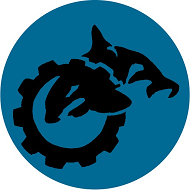In the second mockup of the tiny ROV the design grew significantly in size. The major driver of change between V1 and V2 has been adding a bunch of electronics that live inside the electronics chamber. (Electronics chamber is still being designed and is not shown here). By upgrading to using a raspberry pi zero W …
Author Archives: Aaron Toney
New Research Project: Buoyancy Engines
Rumblefish is spinning up a new long-term project to explore using tiny buoyancy engines in drones and ROVs. Most small to mid size drones and ROVs don’t use a buoyancy control engine at all. They use either an upward facing thruster to push them “down” into the water, or rely on hydrodynamic forces on control …
Cave Pearl Connectors
The current electronics chamber for our tiny ROV is being designed to use this technique, so we could test how well it works for building cheap pressure rated underwater connectors. Regardless of if we end up using the technique, it is worth looking over the Cave Pearl Project‘s work. It is an excellent resource for …
3D Printed Hull Failure
Based on our research at Rumblefish, it is clear that 3D printing to drone hull construction has tremendous potential. That said – there is a lot we have had to learn, and most of those lessons were gifted from unexpected failures. This hull crack is perhaps the biggest failure so far, and it was totally unexpected. …
Float test in a bathtub?
One of the design constraints placed on hull design was the maximum core hull length. While shipping options drove this design constraint, it meant that the core hull could be periodically float tested, and its true vs. calculated displacement checked, in a bathtub. Here you can see our first float tests of the core blacktip …
Hull Painting
Two of the open questions in our research on 3D printed drone hulls were how to waterproof them, and how to get them to be hydro-dynamically smooth. While solvent fuming techniques do address both problems – there were a lot of drawbacks those techniques were not used in creating our larger hulls. In the end, …
Printing A Hull – the halfway point!
The current Blacktip hull was designed to be printed in sections. The thinking was that a multi-part design could have the pieces printed in parallel, greatly speeding up the time to create a custom hull. As a result, the current hull design consists of 12 large sections. A large format, heavily modified, delta 3D printer was …
Researching cast epoxy hulls
Hulls cast from epoxy are ideal for bio-inspired robotics. Casting an epoxy hull into 3D printed disolvable molds enables fast creation and iteration on incredibly comlex hull designs, even those containing the complex organic found in bio-inspired designs. Casting also enables simple embedded inclusions enable features such as threaded bolts extruding from the cast hull, …
Blacktip – Initial hull design
Hull hydrodynamics is a critical design constrains for autonomous craft, become exponentially more important with the intended mission duration. One of the most interesting ways to tackle this problem is to borrow from nature, which has elegantly solved the hydrodynamics problem over and over again in a variety of ways. After a number of computer …
